pzgr40
Well-Known Member
Cutaway model of a German WW2 experimental 105/88mm High Explosive Sabot shell for the Le.F.H 18.
The projectile is of the pressed and rolled steel type, and has a three piece upper sabot that falls into a square groove in the top of the projectile. These sabots have a groove which contain five windings of 1mm dia. steel wire of which both ends have been brassed together. A mild steel ring is rolled in place over the wires as a final lock up ring. On firing, the rifling of the barrel grooves the outer ring , thereby weakening it. On leaving the barrel it brakes, releasing the sabots.
The lower sabot is what makes the projectile very interesting. The base sabot is a one piece sabot with a gas collection chamber. The sabot is a machined steel sabot containing the driving belt, four longitudal 12 mm dia pins at 90 degrees each that fall into mirrored holes in the base of the projectile and prevent the sabot and projectile from rotating independent from each other . Three 6 mm dia pins are placed at 120 degr each radial in the upper part of the sabot; they act as shear pins.
The gas collection chamber is half placed in the sabot, half in the projectiles base. It functions as follows: On firing -during travel through the barrel- the gas collection chamber fills with hot gas through the 4 mm dia hole (red) in the base of the sabot. At the moment the projectile leaves the barrel the pressure behind the projectile suddenly drops to the normal 1 bar outside pressure. However, the gas pressure in the gas collection chamber is still as high as in the barrel, and the 4 mm dia hole is to small to let all this gas escape at once. As a consequence of this the three shear pins break off and the base sabot is ejected.
The projectile reduces in diameter from 105 to 88 mm, a 17 % reduction in diameter and a 30 % reduction in surface area. This will greatly improve the range of the projectile as well as the area fire coverage. With the 150/128mm sabot H.E. shell it was 135% , and as diameter and surface reduction are about the same here, a simular range improvement can be expected.
Normally the 14.8 kg heavy Le.Fh.18 projectile has a 10.675 mtrs range. With a 135 % increase in range this projectile would have a 14.411 mtr range. However, the latter is a presumption.
The fuze used on this projectile is the Dopp.Z.S60 Fliewicht, a time and impact fuze. Below the fuze a Np C98 booster is placed in the main charge.
The shellcase used is the 6342 St which is filled with as sonderkartusche No.6 and has a 1,045 kg charge of Gu.Str.P-A 0,5 , long 175mm, wide 7mm, thick 0,7mm. A 20 grams Nz.Man.Np powder (1,5x1,5mm).
As it was not possibe to make a cutaway over the dowel pins and the anti rotation pins due to the condition of the projectile and the cutaway position of the fuze, the dowel pin is in this cutaway made of a halved – glued on- pin.
Regards DJH
The projectile is of the pressed and rolled steel type, and has a three piece upper sabot that falls into a square groove in the top of the projectile. These sabots have a groove which contain five windings of 1mm dia. steel wire of which both ends have been brassed together. A mild steel ring is rolled in place over the wires as a final lock up ring. On firing, the rifling of the barrel grooves the outer ring , thereby weakening it. On leaving the barrel it brakes, releasing the sabots.
The lower sabot is what makes the projectile very interesting. The base sabot is a one piece sabot with a gas collection chamber. The sabot is a machined steel sabot containing the driving belt, four longitudal 12 mm dia pins at 90 degrees each that fall into mirrored holes in the base of the projectile and prevent the sabot and projectile from rotating independent from each other . Three 6 mm dia pins are placed at 120 degr each radial in the upper part of the sabot; they act as shear pins.
The gas collection chamber is half placed in the sabot, half in the projectiles base. It functions as follows: On firing -during travel through the barrel- the gas collection chamber fills with hot gas through the 4 mm dia hole (red) in the base of the sabot. At the moment the projectile leaves the barrel the pressure behind the projectile suddenly drops to the normal 1 bar outside pressure. However, the gas pressure in the gas collection chamber is still as high as in the barrel, and the 4 mm dia hole is to small to let all this gas escape at once. As a consequence of this the three shear pins break off and the base sabot is ejected.
The projectile reduces in diameter from 105 to 88 mm, a 17 % reduction in diameter and a 30 % reduction in surface area. This will greatly improve the range of the projectile as well as the area fire coverage. With the 150/128mm sabot H.E. shell it was 135% , and as diameter and surface reduction are about the same here, a simular range improvement can be expected.
Normally the 14.8 kg heavy Le.Fh.18 projectile has a 10.675 mtrs range. With a 135 % increase in range this projectile would have a 14.411 mtr range. However, the latter is a presumption.
The fuze used on this projectile is the Dopp.Z.S60 Fliewicht, a time and impact fuze. Below the fuze a Np C98 booster is placed in the main charge.
The shellcase used is the 6342 St which is filled with as sonderkartusche No.6 and has a 1,045 kg charge of Gu.Str.P-A 0,5 , long 175mm, wide 7mm, thick 0,7mm. A 20 grams Nz.Man.Np powder (1,5x1,5mm).
As it was not possibe to make a cutaway over the dowel pins and the anti rotation pins due to the condition of the projectile and the cutaway position of the fuze, the dowel pin is in this cutaway made of a halved – glued on- pin.
Regards DJH
Attachments
-
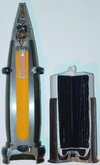 pict.01 - 105-88 HE Sabot, Proj & shellcase Ger WW2 experimental.JPG93.8 KB · Views: 72
pict.01 - 105-88 HE Sabot, Proj & shellcase Ger WW2 experimental.JPG93.8 KB · Views: 72 -
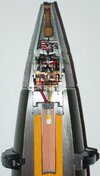 pict.02 - 105-88 HE Sabot fuze and booster, Ger WW2 experimental.JPG92.5 KB · Views: 67
pict.02 - 105-88 HE Sabot fuze and booster, Ger WW2 experimental.JPG92.5 KB · Views: 67 -
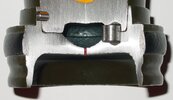 pict.03 - 105-88 HE Gas collection chamber, Ger WW2 experimental.JPG92.8 KB · Views: 54
pict.03 - 105-88 HE Gas collection chamber, Ger WW2 experimental.JPG92.8 KB · Views: 54 -
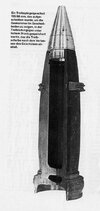 pict.04 - 10,5-8,8 TS.jpg76.3 KB · Views: 43
pict.04 - 10,5-8,8 TS.jpg76.3 KB · Views: 43 -
 pict.05 - 105-88 HE Sabot before firing, Ger WW2 experimental.JPG62.3 KB · Views: 41
pict.05 - 105-88 HE Sabot before firing, Ger WW2 experimental.JPG62.3 KB · Views: 41 -
 pict.06 - 105-88 HE Sabot - after firing in flight, Ger WW2, experimental.JPG72.8 KB · Views: 46
pict.06 - 105-88 HE Sabot - after firing in flight, Ger WW2, experimental.JPG72.8 KB · Views: 46 -
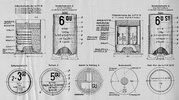 pict.07 - Sonderkartusche ladung 6.jpg368.1 KB · Views: 61
pict.07 - Sonderkartusche ladung 6.jpg368.1 KB · Views: 61
Last edited:
